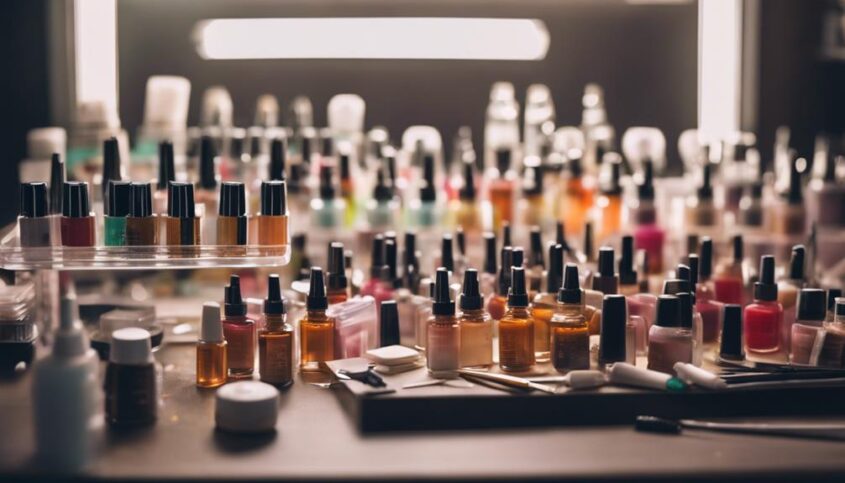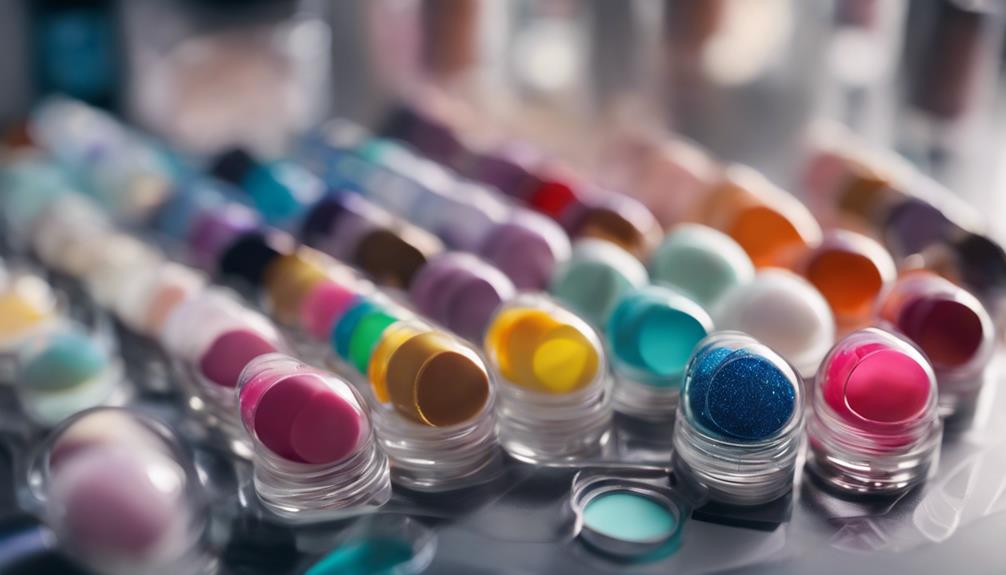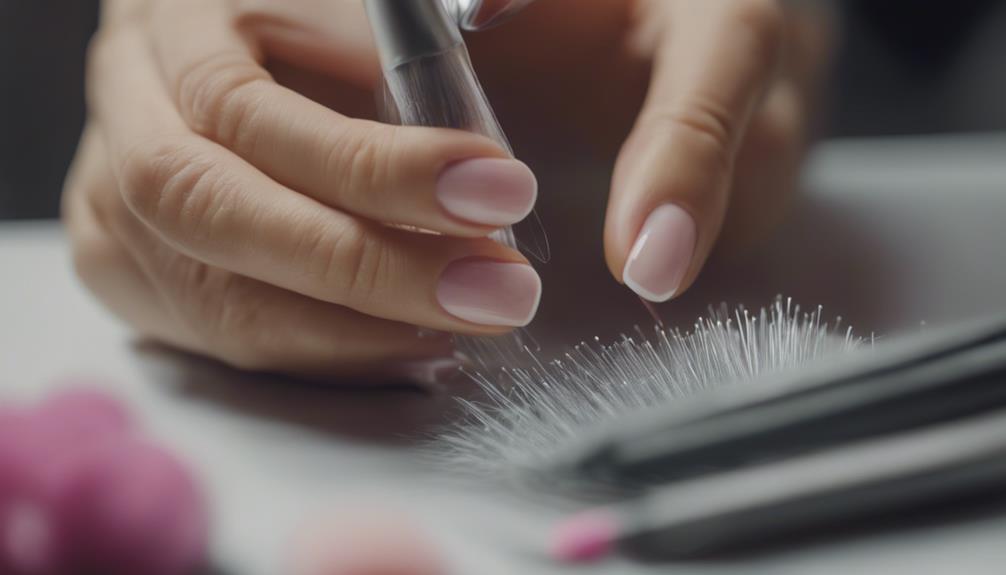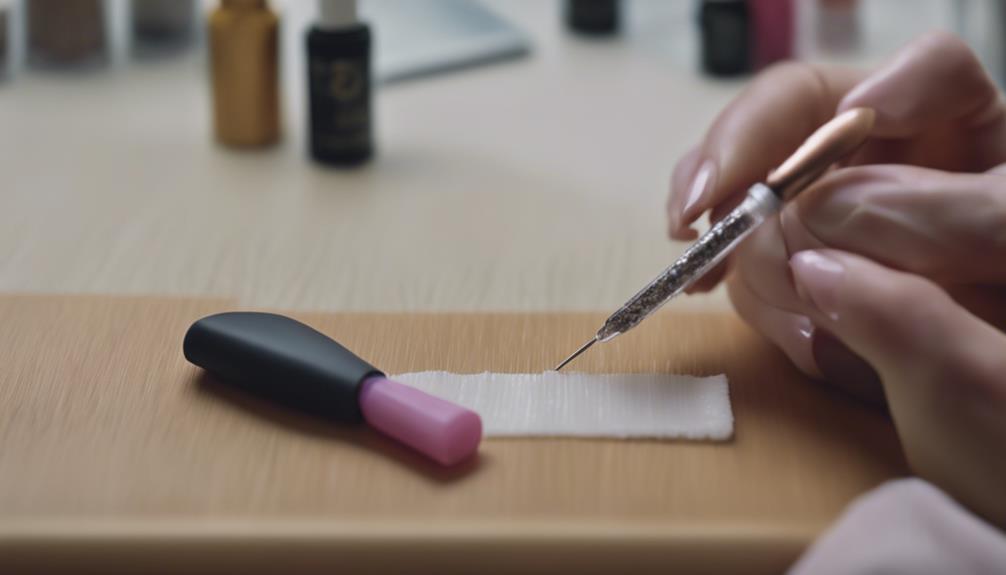What Do Nail Techs Use to Glue on Nails?

Nail technicians use brush-on nail glue, UV nail glue, water-based adhesives, and press-on adhesive tabs to secure artificial nails. These adhesives offer fast drying, strong bonds, and various application techniques for optimal results. Different glues have pros and cons, like quick drying but brittleness or flexibility but longer curing times. Proper preparation, application, and sealing are key for lasting adhesion. Remember, choosing the right glue and technique is essential for a successful nail application.
Key Takeaways
- Nail techs use brush-on nail glue for precise application.
- UV nail glue is used for curing and bonding nails with ultraviolet light.
- Water-based nail adhesives are eco-friendly and non-toxic options.
- Press-on adhesive tabs are mess-free solutions for attaching nails.
- Nail technicians have a variety of adhesive options to cater to different preferences.
Types of Nail Adhesives

Various types of nail adhesives are commonly used by nail technicians to securely attach artificial nails to natural nails. One innovative type of nail adhesive gaining popularity is brush-on nail glue. This adhesive comes in a convenient brush applicator bottle, allowing for precise and easy application. Another cutting-edge option is UV nail glue, which cures and bonds the nails using ultraviolet light, ensuring a strong and durable hold. For those looking for a more natural approach, water-based nail adhesives are emerging as a non-toxic and eco-friendly alternative. These adhesives are free from harsh chemicals, making them a safer option for both technicians and clients. Additionally, press-on adhesive tabs are revolutionizing the nail industry by providing a mess-free and quick solution for attaching artificial nails. With the constant evolution of nail technology, nail technicians have a wide array of adhesive options to choose from, catering to different preferences and needs in the ever-changing beauty landscape.
Characteristics of Nail Glue
What key characteristics define nail glue as an essential component in the application of artificial nails by professional nail technicians? Nail glue, a crucial element in the nail enhancement process, exhibits specific traits that cater to the demands of modern nail artistry. Firstly, fast-drying capabilities are essential for efficiency in applying artificial nails, ensuring quick adherence and minimizing client waiting time. A strong bond strength is another vital characteristic, as it secures artificial nails firmly in place, preventing premature lifting or detachment. Additionally, nail glue with a thin viscosity allows for precision application, enabling technicians to control the amount applied and reducing the risk of excess glue seeping out. Odorless formulations are also favored in modern nail salons, providing a more pleasant experience for both technicians and clients. Lastly, a durable and long-lasting hold is key to client satisfaction, ensuring that artificial nails remain intact and beautiful for an extended period. These characteristics collectively contribute to the effectiveness and quality of nail glue in the professional application of artificial nails.
Application Techniques for Nail Adhesives

In the realm of nail enhancement procedures, mastering precise application techniques for nail adhesives is imperative for ensuring the longevity and quality of artificial nails. To achieve flawless results, nail technicians employ innovative methods that elevate the nail adhesive application process. Here are four key techniques used by nail techs:
- Prepping the Natural Nail: Thoroughly cleaning and dehydrating the natural nail surface is crucial for optimal adhesion. This step ensures that the nail adhesive bonds effectively with the natural nail, enhancing longevity.
- Using the Right Amount of Glue: Applying the correct amount of nail adhesive is vital. Too little may result in premature lifting, while excess glue can lead to bulkiness and potential damage to the natural nail.
- Proper Placement of Artificial Nails: Precision is key when placing artificial nails. Ensuring a snug fit without air bubbles or gaps contributes to the overall durability of the enhancement.
- Sealing the Edges: Securing the edges of the artificial nails with a small bead of glue helps prevent water and debris from seeping underneath, maintaining the integrity of the nail enhancement.
Pros and Cons of Different Glues
When selecting nail adhesives, it is essential to understand the distinct advantages and drawbacks associated with different types of glues. Cyanoacrylate glues, commonly known as super glue, are favored for their quick drying time and strong bond. They are ideal for acrylic or artificial nail applications but can be brittle and prone to cracking. Gel-based adhesives offer flexibility and durability, making them suitable for natural nail overlays, but they may take longer to cure. Resin glues are prized for their non-yellowing properties and are often used in silk or fiberglass nail enhancements, yet they can be challenging to work with due to their runny consistency. Acrylic adhesives provide a solid bond and are frequently used in sculptured nail techniques, but they require careful application to avoid air bubbles. Each type of glue has its own set of advantages and limitations, so choosing the right one depends on the specific needs of the nail application.
Tips for Ensuring Proper Adhesion

To ensure proper adhesion when using different types of nail glues, implementing specific techniques can enhance the longevity and strength of the bond. Here are some innovative tips to help you achieve optimal adhesion:
- Prep the Nail Surface: Thoroughly clean the natural nail surface to remove any oils, dust, or debris that could hinder adhesion.
- Proper Application Technique: Apply a small, even amount of glue to the natural nail and another small amount to the artificial nail tip for balanced adhesion.
- Avoid Excess Glue: Using too much glue can lead to a bulky and less durable bond. Apply just enough to cover the nail surface evenly.
- Secure and Press: After aligning the artificial nail tip with the natural nail, press down firmly for a few seconds to ensure a strong and lasting bond.
Frequently Asked Questions
Can Nail Glue Be Used to Attach Nail Art or Embellishments on Top of Artificial Nails?
Yes, nail glue can securely attach nail art or embellishments on top of artificial nails. Its strong adhesive properties ensure long-lasting results. Ensure proper application and use to prevent any damage or lifting.
How Long Does Nail Glue Typically Last Before Nails Need to Be Reattached?
The longevity of nail glue varies based on factors like application technique and user habits. Typically, nail glue can last anywhere from 1 to 3 weeks before requiring reattachment. Proper care and maintenance can extend this duration.
Are There Any Potential Health Risks Associated With Using Nail Adhesives Frequently?
Frequent use of nail adhesives may pose potential health risks due to the chemicals present. Skin irritation, allergies, and respiratory issues could arise. It is advisable for individuals, especially professionals, to adhere to safety protocols and seek alternatives when necessary.
Can Nail Glue Be Easily Removed Without Damaging Natural Nails?
Efficient nail glue removal without harming natural nails is achievable. Techniques like soaking nails in acetone or using a nail polish remover with acetone can help dissolve the adhesive for safe removal, preserving nail health.
Are There Any Specific Ingredients or Chemicals in Nail Adhesives That Customers Should Be Aware of for Allergies or Sensitivities?
When selecting nail adhesives, customers should be mindful of potential allergens or sensitivities. Ingredients like formaldehyde, toluene, and dibutyl phthalate are commonly found in nail glues and may trigger reactions in some individuals. Always consult with a professional for guidance.




